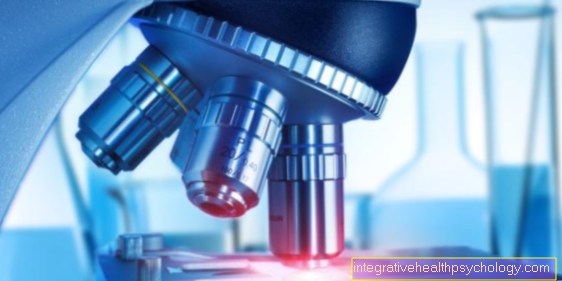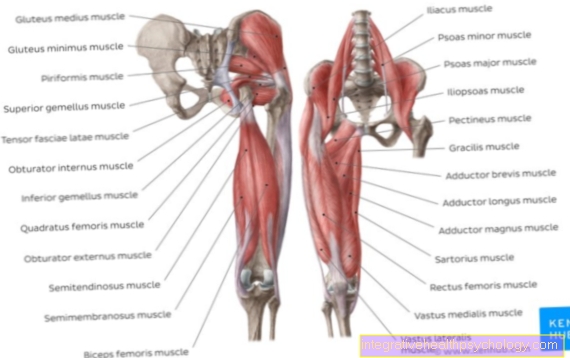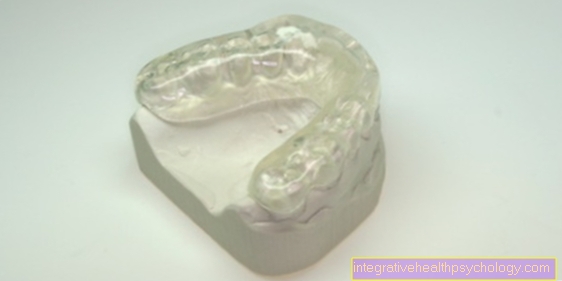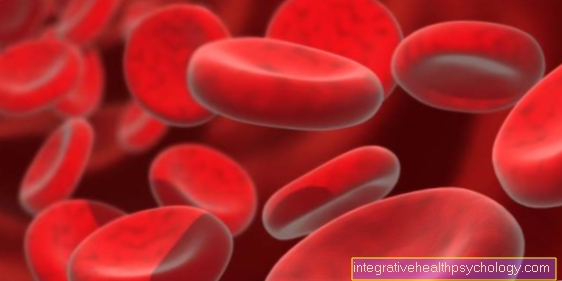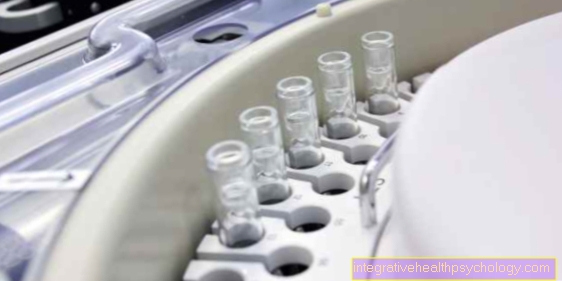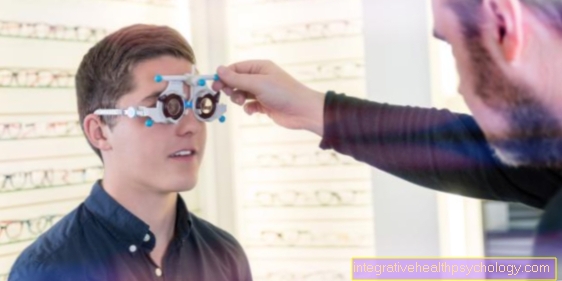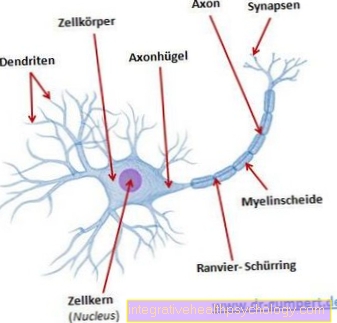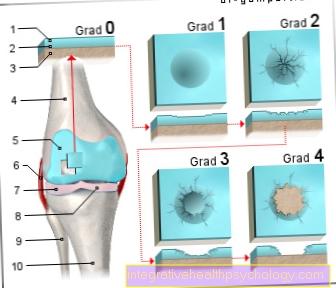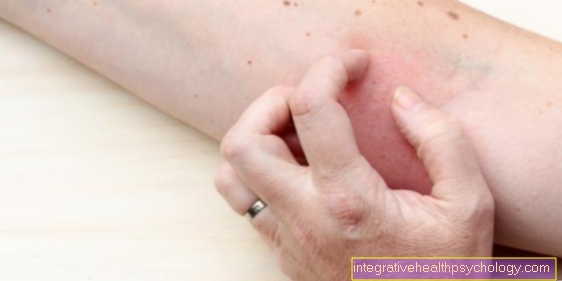Chromosome aberration - what does it mean?
Introduction - what is chromosomal aberration?
A chromosome aberration describes a deviation from the normal human chromosome structure. A normal human chromosome set has 23 chromosome pairs of the same type, which contain the entire genetic material. A chromosome aberration can be a numerical as well as a structural deviation of the chromosome set.
Chromosomal aberrations are the most common cause of prenatal miscarriage. However, there are also viable forms of chromosomal aberrations, such as Down's syndrome (Trisomy 21) or Klinefelter Syndrome (XXY syndrome).
A chromosome aberration can be recognized by creating a karyogram. This can be compared with a healthy karyogram, so that deviations are noticed immediately.
Read more about this under: Chromosome mutation

What are numerical chromosomal aberrations?
Numerical chromosome aberrations describe a set of chromosomes that have a different number of chromosomes. Individual chromosomes can be duplicated or missing (Aneuploidy) or the complete set of chromosomes be duplicated (Polyploidy).
The best known and most widespread numerical chromosomal aberration is trisomy 21 (Down syndrome). In this disease, the 21st chromosome is present in triplicate. The chance of having a child with trisomy 21 increases with the age of the mother. Children with Down syndrome fail:
- Short stature
- Four-finger furrows
- (Mongoloid) eyelid axes that extend obliquely outwards
- decreased motor skills and intelligence
The mental retardation in particular varies greatly with the individual patients, so that individual treatment, support and care are in the foreground.
Life expectancy is only minimally reduced by trisomy 21. This is the case with other forms of trisomy, such as trisomy 13 (Patau syndrome) and trisomy 18 (Edwards Syndrome) not so, here life expectancies are less than one year.
Other numerical chromosomal aberrations that affect the sex chromosomes are Klinefelter syndrome and Ullrich-Turner syndrome.
Klinefelter syndrome affects men. Instead of one, they have two X chromosomes. The most noticeable symptom is tall stature caused by a lack of testosterone.
In Turner syndrome, affected women lack an X chromosome. Due to the lack of estrogen and gestagen, connective tissue grows through the ovaries and women remain sterile for life.
Read more about this at: Trisomy 13 in the unborn child
What are structural chromosome aberrations?
Structural chromosome aberrations are deviations from chromosomes in terms of their structure. In contrast to the numerical chromosome aberrations, the normal number of chromosomes (23 homologous pairs, 46 chromosomes in total) is retained. There are several forms of structural chromosomal aberrations, such as:
- DELETION: In the case of deletion, a chromosome segment and thus part of the genetic material is lost. This is an example of such a disease Cat Scream Syndrome. Such children stand out with high-pitched screams, are often short of stature, have poorly developed muscles and a small head.
Wolf-Hirschhorn syndrome is also caused by a deletion. Characteristic of this disease are the numerous epilepsy attacks in the patient.
- TRANSLOCATION: Another structural chromosomal aberration is translocation. Here, a chromosome segment is shifted to another, non-homologous chromosome. A distinction is then made between a reciprocal and a non-reciprocal translocation.
- INVERSION: The inversion describes a structural chromosome aberration in which a chromosome segment is reversed.
In general, a distinction is made between a balanced and an unbalanced chromosome change in structural chromosome aberrations. The balanced one has no disease value for the wearer, whereas the unbalanced one leads to physical symptoms.
You might also be interested in: Chromosome set
Causes of Chromosomal Abnormality
There are different causes for the numerical and structural chromosomal aberrations. The numerical chromosome aberration has a different number of chromosomes, whereby the chromosomes themselves look normal.
At a Aneuploidy if single chromosomes are duplicated or missing, as for example in trisomy 21. The most common cause of this is a non-disjunction (Non-separation) of the chromosomes during meiosis. Meiosis has the function of producing germ cells. As a genetic material, these contain a single chromatid chromosome, which is available for fertilization.
If the homologous chromosomes are not separated (Meiosis I.) or to a non-separation of the sister chromatids (Meiosis II), there are two chromatids in the germ cell. If this egg cell is fertilized, the cell has a total of three chromatids and one speaks of one Trisomy.
In the case of structural chromosome aberrations, the cause does not lie in the divisions of the meiosis. In this type of chromosome aberration, the chromosome set consists of the desired 23 homologous chromosome pairs, although individual chromosomes have a different structure.
This deviation can, for example, be the gene mutations already described above:
- Deletion (a piece of the chromosome is missing)
- Duplication (a piece of the chromosome is duplicated)
- Translocation (part of one chromosome has been incorporated into another chromosome)
The cause of these deviations is usually a faulty crossing-over during meiosis. The second cause is a faulty repair of double-strand breaks in the genome.
That could also be of interest to you: Cell nucleus division
What is the chromosome aberration test?
There are various tests that can be used to detect chromosome aberrations in the unborn child. However, there are also so-called in-vitro and in-vivo chromosome aberration tests that are used in toxicology.
In vitro chromosomal aberration test
The in vitro chromosomal aberration test involves treating a cell culture with a substance that is suspected of causing chromosomal aberrations. The cell culture consists of cells that come from mammals. For example, cells from mice or lymphocytes from human blood are possible.
These cells are first cultivated so that they grow under optimal conditions. Next, they are treated with the substance to be examined. For example, it can be a dissolved substance that is added to the cell culture.
After a certain exposure time, the cells are then examined under the microscope. In particular, one looks at the chromosomes in the metaphase and checks them for changes.
It is also useful to create a control culture that has not been treated with the test substance. With this control, the sets of chromosomes can be better compared with one another.
In vivo chromosomal aberration test
The in vivo chromosome aberration test is similar to the in vitro test with the difference that the test substance is introduced directly into the bone marrow of the living mammal. This created realistic conditions because the substance is in the organism.
Here, too, the set of chromosomes is checked for deviations. These two methods can be used to test substances for their mutagenic effect.
What tests are there?
There are several tests that can be used to examine chromosomal aberrations. On the one hand, there are examination options that can be used to test whether a substance (e.g. nicotine) Triggers chromosomal aberrations and thus increases the chance of developing cancer. These tests are called In vitro- and In vivo chromosomal aberration tests and are carried out by toxicologists.
However, there are also tests that can be done in pregnant women to check whether the unborn child has a chromosomal aberration. There are several options here.
The first option is chromosome analysis, which is still the gold standard today. Amniotic fluid or umbilical cord blood, for example, can be used as test material. Both numerical and structural chromosomal aberrations can be diagnosed under the microscope.
The second option would be a simple ultrasound, which can often detect a chromosome change. One sign of a chromosome disorder is the absence of the nasal bone.
Another test that takes less time than chromosome analysis (Duration: approx. Several days) is the FISH test (Duration: a maximum of 2 days). With the help of the FISH test (Fluorescence in situ hybridization test) chromosomes 13, 18, 21 and the X and Y chromosomes in fetal material (e.g. amniotic fluid) are shown in color. A numerical chromosome aberration can thus be determined by simply counting it.
You might also be interested in the topic: Functions of the cell nucleus
CLINIC: Which diseases are caused by chromosomal aberrations?
Chromosomal aberrations are responsible for a large number of spontaneous abortions before birth and for many diseases. Of all of them, five in particular are widespread.
Down syndrom
The best known among them is trisomy 21, better known as Down syndrome.
These children stand out due to their short stature, four-finger furrows on their hands and often poor intelligence. It is also associated with an increased incidence of heart defects and malformations of the gastrointestinal tract.
However, with good treatment and support, the children can have an almost normal life expectancy.
Patau Syndrome vs. Edwards Syndrome
Trisomy diseases also include Patau syndrome (trisomy 13) and Edwards syndrome (trisomy 18), with life expectancy for both diseases being less than one year.
Patau syndrome in particular causes a high number of miscarriages, which is why many children die before birth. However, cases have also been described in which the extent of the malformations is smaller and they reach the age of 10.
Read more about this: Trisomy 13 in the unborn child
Klinefelter Syndrome
Like trisomies, Klinefelter syndrome is a numerical chromosomal aberration. In this disease, male patients have an additional X chromosome and are noticeable for their pronounced tall stature and underactive testes with accompanying hormonal changes.
Ullrich-Turner syndrome
In contrast, the Ullrich-Turner syndrome lacks an X chromosome, so that these patients only have 45 chromosomes in total. Only women are affected.
The female patients have malformed genital organs and remain sterile for life. In addition, they often stand out due to the widening of the neck due to a so-called wing skin.
Recommendations from the editorial team
- Chromosome set
- Functions of the cell nucleus
- DNA
- Mitosis - Simply Explained!
- Prader-Willi Syndrome
- Angelman Syndrome

